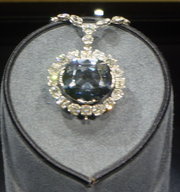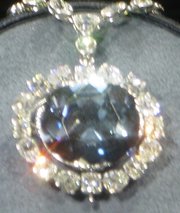Hope Diamond
|
|
The Hope Diamond is a large, deep blue diamond, currently housed in the Smithsonian Institution. The diamond is legendary for the misfortunes it supposedly visits upon its possessors. The Hope Diamond exhibits red fluorescence under ultraviolet light and is classified as a Type IIb diamond.
| Contents [hide] |
French Blue
It is believed that the Hope diamond's history can be traced to a blue diamond named "Tavernier Blue," which was originally mined from the Kollur mine in Golconda, India, and was a crudely cut triangle shape of 112 3/16 carats (22.44 g). French merchant traveler Jean-Baptiste Tavernier purchased it sometime in 1660 or 1661.
In 1668, Tavernier sold the diamond to King Louis XIV of France. Sieur Pitau, the court jeweller, cut it and produced a 67 1/8 carat (13.4 g) stone. The stone became known as "the Blue Diamond of the Crown" or "the French Blue." It was set in gold and suspended on a neck ribbon for the King to wear on ceremonial occasions. In 1749, King Louis XV had it set on his pendant for the Order of the Golden Fleece. After his death, it fell into disuse.
During the French Revolution, when King Louis XVI and Marie Antoinette were held in prison, the pendant with the diamond was stolen on September 11, 1792, when six men broke into the house used to store the crown jewels. One of the robbers, cadet Guillot, took it to Le Havre alongside the Gôte de Bretagne spinel and then to London where he tried to sell the jewels. In 1796, apparently seriously in debt, he handed the spinel to Lancry de la Loyelle, who had Guillot put into prison for his trouble. There is no record of what had happened to the diamond.
The Hope diamond was recorded in the possession of a London diamond merchant Daniel Eliason in September 1812, which marks the earliest point that the exact history of the Hope diamond can be definitively fixed. This diamond, now known as the "Hope Diamond," was generally believed to have been cut from the French Blue, a fact that was finally verified in 2005. It is often pointed out that the Hope Diamond came into recorded history almost exactly 20 years after the theft of the French Blue, just as the statute of limitations for the crime had expired.
It is believed that it may have been acquired by King George IV of the United Kingdom, although there is no record of the ownership in the Royal Archives at Windsor.
Hope Family
Next the diamond appeared in the gem collection of Henry Philip Hope in 1824, who had it set on a brooch and sometimes loaned it to Louisa Beresford, wife of his brother Henry Thomas Hope to host society balls. Henry Philip Hope died in 1839 and his three nephews fought in court for ten years over his inheritance until Henry Hope acquired the gems, including the Hope Diamond. The Hope Diamond was in display in the Great Exhibition of London in 1851 and Paris Exhibition Universelle in 1855 but was usually kept in a bank vault.
Henry Hope died on December 4, 1862 and his wife Adele inherited the gem until her death in March 31 1884. The next owner was Henry Francis Hope Pelham-Clinton, son of a daughter of Henry and Adele Hope, Henrietta and the 6th Duke of Newcastle, who had to add one additional Hope to his name. He received his inheritance in 1887. However, he had only a life interest to his heritance, meaning that he could not sell anything.
Sir Francis' expensive tastes brought him to bankruptcy. In 1894 he married US actress May Yohe. Yohe later claimed that she had worn the Hope Diamond in social gatherings but Sir Francis claimed otherwise. In effect, Sir Francis lived on his wife's salary from her theatrical performances. His bankruptcy was discharged in 1896 but he sought a court's permission to sell his life inheritance. In 1901 he received permission to sell the Hope Diamond.
Road to USA
The diamond was sold for £29,000 to London jewel merchant Adolf Weil, who sold it to US diamond dealer Simon Frankel, who took it to New York. There it was evaluated to be worth $141,032 (equal to £28,206 at the time). In 1908, Frankel sold the diamond to Salomon Habib in Paris for $400,000. It was presented in an aborted auction on June 24 1909 alongside other possessions of Habib to settle his debts. Habib sold the Hope Diamond to Paris jewel merchant Rosenau for a sum equal to $80,000. In 1910, Rosenau sold it to Pierre Cartier for 550,000 francs.
Cartier re-set the stone and in 1911 sold it to US socialite Evalyn Walsh McLean, who initially rejected it but afterwards wore it in every social occasion she organized. When she died 1947, she had willed the diamond to her grandchildren though her property would be in the hands of trustees until the eldest had reached 25 years of age, which would have meant at least 20 years in the future. However, the trustees gained permission to sell her jewels to settle her debts, and in 1949 sold them to New York diamond merchant Harry Winston.
Winston exhibited the Hope Diamond in his Court of Jewels, a tour of jewels around USA, and various charity balls over the years but did not sell it. In August of 1958, the diamond was exhibited in the Canadian National Exhibition. He also had the bottom facet cut to increase the diamond's brilliance and donated it to the Smithsonian Institution on November 7, 1958, sending it through the US Mail. Winston died of a heart attack in 1978.
Smithsonian years
The Hope Diamond is part of the National Gem Collection in the Smithsonian Institution, in the National Museum of Natural History. At first it was placed inside a glass-fronted safe in a gem hall. In 1962 it was loaned to an exhibition of French jewellery in Paris and in 1965 to South Africa to the Rand Easter Show. After renovations to the gems exhibit were completed, the diamond was moved into its own display room, adjacent to the main gem exhibit, where it rests on a rotating pedestal. The National Gem Collection is exhibited within the Janet Annenberg Hooker Hall of Geology, Gems, and Minerals. The Hope Diamond is the most popular jewel on display.
The most recent examination in December,1988 by Graduate Gemologists of the Gemological Institute of America show the diamond to weigh 45.52 carats (9.104 g) and it is described as "Fancy dark grayish-blue". The stone exhibits a unique delayed fluorescence; like many other gemstones, it emits a dim light under ultraviolet light, but when the light source is removed, the diamond produces a brilliant red phosphorescence. The clarity was determined to be VS1, with whitish graining present. The cut was described as being "cushion antique brilliant with a faceted girdle and extra facets on the pavillion." The dimensions in terms of length, width, and depth are 25.60mm X 21.78mm X 12.00mm.
On the 9th of February 2005, the Smithsonian Institution has published the finding of its year-long computer aided geometry research on the gem and officially acknowledged the Hope Diamond is part of the stolen French Blue crown jewel. [1] (http://www.wired.com/news/technology/0,1282,66560,00.html?tw=wn_tophead_7)
The Curse
First stories about the supposed curse of the Hope Diamond surfaced 1909. In the June 25 issue of The Times an article written by the Paris correspondent listed a number of supposed owners who had come to an ignoble end.
The curse's origins are from India. According to legend, Tavernier stole the diamond from a Hindu idol. The diamond was one of the two eyes of the idol, and when the priests noticed it was missing, they placed a curse on whomever owned the diamond. One reason that this is not accepted is that the Hope Diamond's sister has not been found. Tavernier supposedly died of fever soon after - when he actually lived to 84 (and was not torn apart by wolves, either). The Hope diamond was blamed for the fall from the king's favor of madame Athenais de Montespan and French finance minister Nicolas Fouquet, not to mention the beheading of Louis XVI, Marie Antoinette and Princes de Lamballe. Story added fictitious persons like a diamond cutter Wilhelm Fals (supposedly ruined when his son Hendrik stole it), Hendrik Fals (suicide) and Francois Beaulieu (starvation after he had supposedly sold it to Daniel Eliason).
Simon Frankel (alleged to be in financial difficulties) had supposedly sold it to one Jacques Colot (suicide); the next owner, Russian prince Kanitowski who first had supposedly lent it to French actress Lorens Ladue, who he later shot, and was later himself killed by revolutionaries; jeweler Simon Montharides (killed with his family) and Turkish Sultan Abdul Hamid (the diamond was blamed for his forced abdication) who had supposedly killed various members of his court for the stone. There is no evidence that most of these people ever existed.
May Yohe later blamed the Hope Diamond for her misfortunes like her divorce from Sir Francis and her unsuccessful stage career. In 1920 she persuaded US silent movie producer George Kleine to produce a 15-episode serial The Hope Diamond Mystery, which added more fictitious characters to the tale. It was not successful. 1921 she hired Henry Leyford Gates to help her to write The Mystery of the Hope Diamond with more characters, including a fictional version of Tavernier and added Marat to the victims. She also wore a copy of the Hope Diamond, probably trying to generate more publicity to further her career.
Evalyn Walsh MacLean also added her own tales, including that one of the owners was Catherine the Great. McLean was known to bring the diamond out for friends to try on, including that of President Warren G. Harding and First Lady Florence Harding. Additionally, McLean often strapped the diamond to her pet dog's collar while in residence at Friendship, in north west Washington D.C.
Books
- Marian Fowler, Hope: Adventures of a Diamond, Ballantine (March, 2002), hardcover, ISBN 0345444868
- Susanne Steinem Patch, Blue Mystery : The Story of the Hope Diamond, Random House (April, 1999), trade paperback, ISBN 0810927977; hardcover ISBN 0517636107
- Janet Hubbard-Brown, The Curse of the Hope Diamond (History Mystery), Harpercollins Childrens Books (October, 1991), trade paperback, ISBN 0380762226bg:Хоуп


